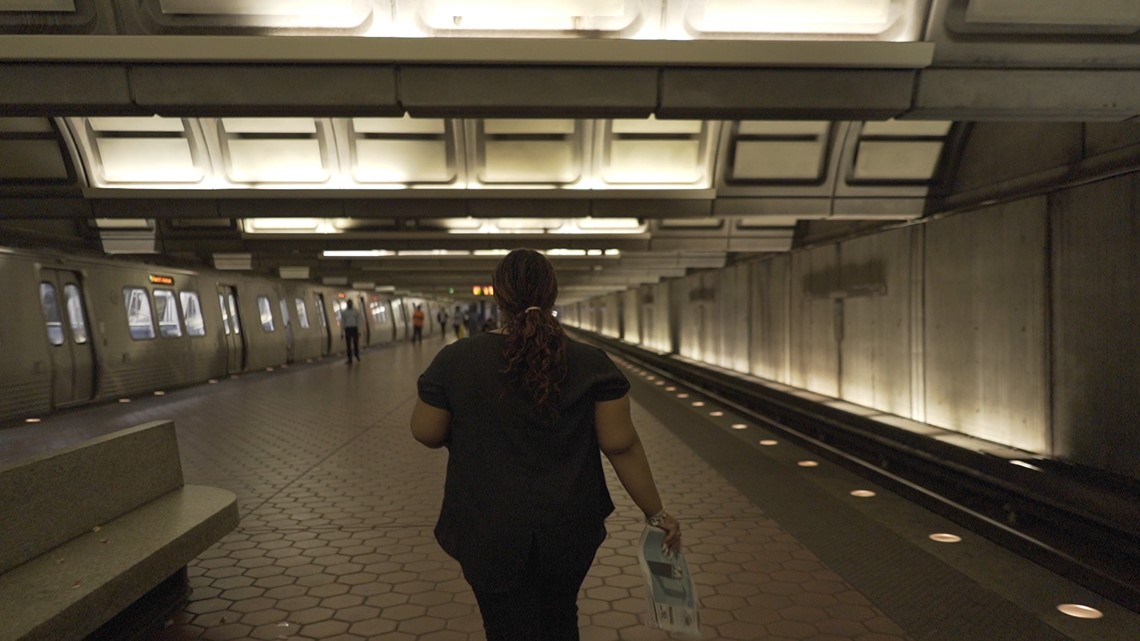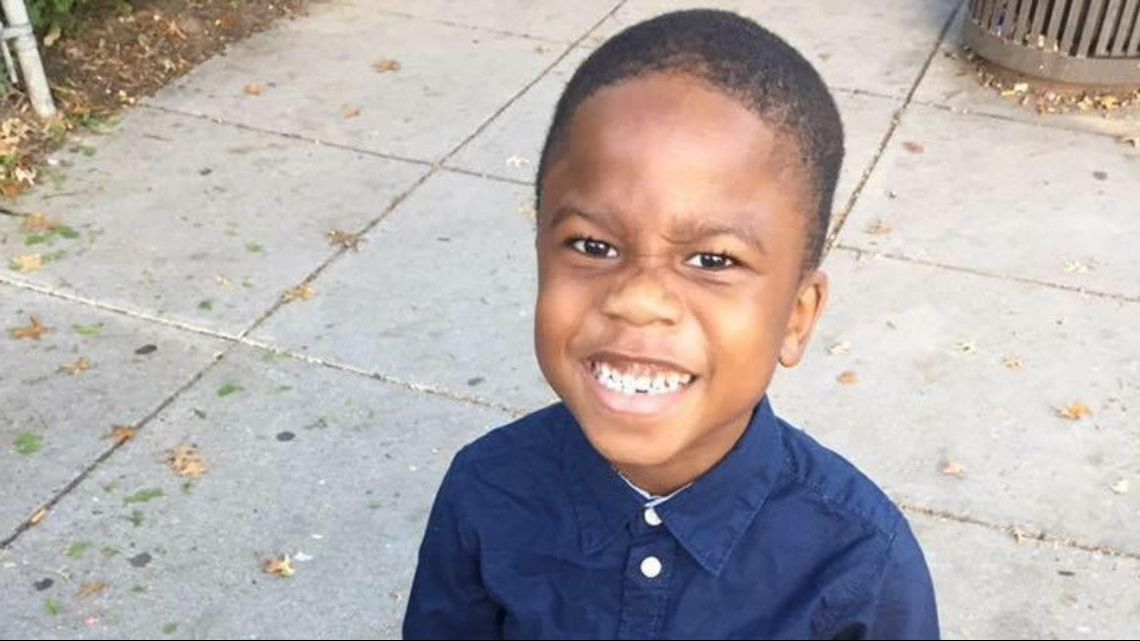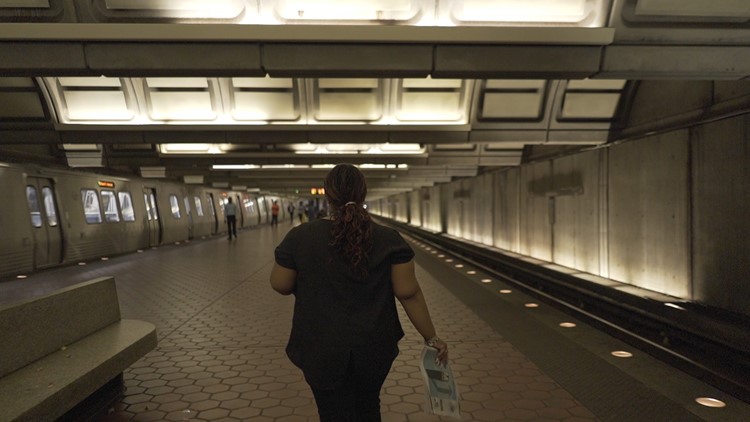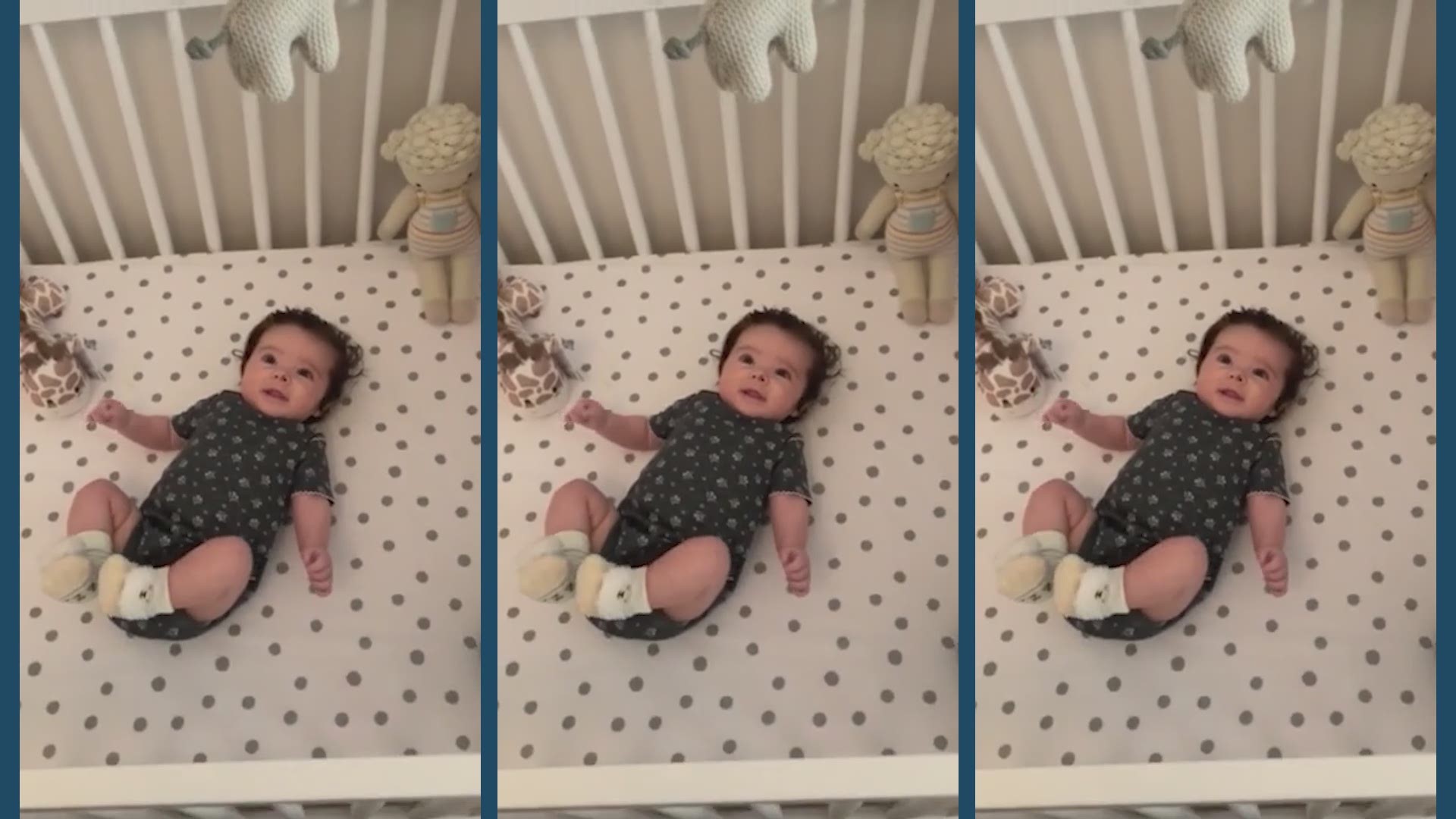Watch the full Mothers Matter series HERE.
The morning rush hour on the Washington D.C. metro is no joke.
There is the clamor of people rushing up and down the occasionally stopped escalators into the impressive art-deco style stations, the dinging of the doors of the cars as they slide open and close, and the murmur of people on the move.
Many of the metro stops are - upon first viewing - impressive works of art but often eventually fade in the mind of the busy commuter until the once stunning ceilings are just part of a monotonous, somewhat inconvenient routine.
Tanazia Matthews grew up riding the green line from Anacostia station. Unlike the soaring, cathedral height ceilings in many of the other stops, the Anacostia station has low, wave-like ceilings that can feel even lower during a crowded rush hour.
At 15, a very pregnant Tanazia stood on the platform in dead of winter, after a very early bus ride from her mother’s house. If she did not time her routine to the minute, she could miss her ride to the doctor’s office, miss the appointment, and have to start her hour-long commute back east of the river without having even seen her medical practitioner.
Her story is not unlike many women from east of the Anacostia River in Washington D.C. She – like hundreds of women before and after her - believed the best care was outside of her part of town and was willing to make the trek to make sure her future son got it.
She was one of the lucky ones able to make the trip and have a safe birth. But across the United States, hundreds of women are dying each year after giving birth and black women are three to four times as likely to die post-childbirth than white women.
No Maternity Wards East of the River
While there are places to get prenatal care east of the Anacostia, there are no official maternity wards.
Access to care has been an ongoing debate in the nation’s capital for decades and in recent history, things have gotten harder for expecting women in the eastern side of the city.
In the second half of 2017, United Medical Center permanently shuttered its maternity ward after the D.C. Department of Health closed it for “deficiencies in screening, clinical assessment and delivery protocols.”
Providence Hospital closed its obstetrics ward in October, in what was largely reported as a cost-saving measure.
Tanazia might not have known all the statistics at 15, but she knew what people around town were saying about their neighborhood hospital before it closed. A teen in glasses and honor roll student with an easy, joyous laugh, she said once she learned she was going to be a mother, everything changed.


“So I started making cautious decisions but not as regular Tanazia, I was making them as mother Tanazia,” she explained. “Like the decisions I make not only affect me but also affect the life that is watching me.”
She took a bus to the metro, then another bus to make it to Washington Hospital Center for her appointments. Tanazia explained she felt it was her best option, and she wanted to see doctors at the hospital she would eventually deliver in. A hospital, of course, that was not in her neighborhood.
Two Sides of the River
“When you look at communities in Wards 7 and 8, right, that are designed to have less than,” explained Aza Nedhari, one of the founders of a community organization helping mothers called Mamatoto Village. “There are two sides of the river. You’re walking across a bridge that has two different realities.”
Wards 7 and 8 are the two parts of the city east of the river, connected to the bustling metropolis of Washington D.C. by a smattering of bridges. Both wards are more than 90 percent black or African American, according to the most recent U.S. Census.
“You have one community that has the highest rate of, well, everything! Poverty, high school drop outs, teen parents, single parent homes, the lowest indicators of wellbeing,” Nedhari said. “You contrast that to [the other side of] the river, where their well-being is 93 percent, where the median income is six figures, where there is generally two-parent households. Where they have a Trader Joe’s in their community, compared to the bodega that is across the river.”
Often the wards east of the Anacostia River make up about one third of the births in the district each year. Records from the D.C. Department of Health show Ward 8 had 3,387 live births 2015-2016, while Ward 7 had 2,575. By comparison, Ward 3 had just 1,537 births in the same time period.
The D.C. Department of Health says they are aware of the ongoing issues facing the underserved parts of the city.
“Our mission is to ensure that every resident of the District of Columbia lives their best health,” Dr. LaQuandra S. Nesbitt, the director of D.C. Department of Health said. “…but there are some parts of the city where we’re leaving some folks behind.”
Nesbitt pointed out they do not just look at whether or not a service is available in a geographic way to communities; they also want to make sure the care provided is safe and quality.
“It’s also important to note that for a decade that 90 percent of the women in Wards 7 and 8 chose not to deliver their babies in Wards 7 and 8,” she said.
According to D.C. Department of Health statistics, United Medical Center and Providence each delivered about 10 percent of births for the women living in Wards 7 and 8 during 2015-2016.
Below is a map showing how many babies from each ward were born between 2015-2016. The red dots indicate hospitals that closed their maternity wards. You can also see the route Tanazia took to the doctor.
Black Mothers
For every 13 white women who die from pregnancy related causes, there are 44 black women who pass away.
According to the Centers for Disease Control, around 700 women in the United States die each year after childbirth, and more than half of them are preventable.
Those deaths impact black women disparately more than white women; for every 13 white women who die from pregnancy related causes, there are 44 black women who pass away.
In Washington D.C., 17 of the 18 women who died from pregnancy-related causes between 2012 and 2016 were black. According to the D.C. Department of Health, the nation’s capital has the eighth worst pregnancy-related death rate in the nation. Other reports have previously labeled D.C. as the worst in the country.
“Washington DC is the most dangerous place to give birth in the United States if you are African American," Dr. Barbara Levy from the American College of Obstetricians and Gynecologists. She is the Vice President, Health Policy and administers ACOG's Office of Global Women's Health programs. "If you are a white woman, you’ll do very well in the nation’s capital. We have a major disparity problem here in D.C."
“The data that’s often used that cites Washington D.C. as the number one in maternal mortality is old,” Dr. LaQuandra Nesbitt, the director of the D.C. Department of Health, said.
Health officials argue the maternal mortality ratio – based on 100,000 births – is not a fair way to compare the District of Columbia to other cities. After all, in recent history D.C. typically had about 20,000 live births per year. To get the ratio, you then have to multiply the number of deaths by five.
“When people hear the rate being 20 or so women, that’s not the actual number of women who die every year,” Nesbitt said. “We don’t want a community being terrified about black women being pregnant. We don’t want a community that thinks the statistics are just there and there is inaction. We want everyone to know that this is something we all have to rally as a community to know the facts.”
But even with the ratio deemed unfair by the D.C. Department of Health, the facts are between 2012-2016, there were a total of 18 pregnancy-related deaths in the district. Of these, 17 women were black, and one was Hispanic.
Watch the video below to hear full comments from Dr. Nesbitt of the D.C. Department of Health.
So far, it is unclear how the closure of the two maternity wards at Providence and United Medical Center in the latter half of 2017 has impacted maternal mortality rates in the nation’s capital. D.C. Department of Health officials rejected our request for the data, and said it is not ready yet. Health officials said they do not expect it to be released until 2019.
"Sharing that data would be extremely irresponsible," Tom Lalley, spokesperson from the D.C. Department of Health, said in a follow up call on October 26. "We wouldn't share data we don't have confidence in."
Solutions


Tanazia never missed an appointment. She gave birth to her son, Jalil Jr., at Washington Hospital Center on the east side of the northwest quadrant of the city. A bright, cheerful kid who likes to dance, he just entered elementary school. Tanazia and her son’s father are still together and the family lives in a home together in the northeast part of town.
Tanazia graduated at the top of her class in high school, and immediately went on to college. She graduated from Trinity Washington University, then went to work for a local organization called the Healthy Babies Project. The organization helps other at-risk teen moms get access to the best care available and coaches them on how to be successful both pre and post birth of their babies. She takes them to their appointments, to resource fairs, and does home visits, all while coaching young women through the same experience she had at that age.
“Sometimes I don’t realize how much of an impact I have. Until we’re like in meetings and they’re like, who is your role model and they’re like ‘Miss Tanazia!’ And I’m like ‘Aww, me, really?’” she said. “But it feels good to know that I’m giving back and even though I’m so young, girls my age or younger than me still look up to me and they’re like you have something going here, you have a goal and you know what you want to do and I don’t mind helping people get there.”


Tanazia typically recommends to her clients travel out of the neighborhood for their obstetrical care.
She said she just wants what is best for them, even if it means a long trip. But in her ideal world, the best care would come to her moms, in their own part of town.
“I feel like first, people have to change their perspective of the different stereotypes within the neighborhoods and then get to changing the actual neighborhood,” she said. “Not for gentrification purposes, but changing it for those that actually live there and absorb the resources.”
Community organizations are trying to do just that. Howard University partnered with Unity Health Care to provide more care in historically underserved neighborhoods. Together, officials are planning to open an East of the River Health Center in early 2019 that will have exam rooms and “seamless” access to Howard University Hospital.
City officials hope to build a new hospital in Ward 8 that would replace United Medical Center that would be run by George Washington University Hospital. It is not slated to open until 2023.
In the same building, Community of Hope helps low-income and underserved families get access to healthcare - including prenatal care with obstetricians on staff - provides job training to those in need, and offers help to the homeless.
Mamatoto Village – which Aza Nedhari co-founded - is another non-profit working to provide support services to women before and after their babies are born, plus training local women to become perinatal health workers and advocates for other women during their child birthing experiences. They have their staff visit women at home during pregnancy, and hold “Mama Mingles” so expectant women can meet other moms giving birth around the same time.
Maternal mortality review committees are teams of qualified volunteers that inspect each maternal death. They look for gaps in coverage, where things are going wrong and collect more data for each state that has one. Washington D.C.’s own committee is getting started this fall. At the national level, a bipartisan bill in U.S. Senate that has yet to be introduced on the floor that would direct the Department of Health and Human Services to give grants to states that do not already have their own. The U.S. House version of the bill is still in committee.
A Democrat-led bill, the Maternal Care Access and Reducing Emergencies (CARE) Act, aims to tackle the racial disparity that leads to black women dying at higher rates post-childbirth. If passed, the bill would give young people entering the medical field access to implicit bias training, and to create a program that would create a Pregnancy Medical Home program, which helps support prenatal care providers as they increase access to care and improve outcomes for the pregnant Medicaid population. Both the House and Senate versions of that bill are in committee.
The American College of Obstetricians and Gynecologists started a program called AIM, which works with many provider groups to develop care “bundles,” which are a set of activities that they hope will help to improve the quality of care delivered in a hospital, even when staff are exhausted or distracted. Another bill stalled in Congress, the MOMS Act, would help fund these efforts and standardized best practices.
Another doctor we spoke with suggested creating a national database that would compile all maternal mortality deaths and information. Right now, the CDC collects data from each state, but it is not all uniformly reported the same way.
But not everyone we spoke with thinks a federal bill or program is the solution to improve survival rates for black women.
"For so long we’ve been hospital-centric or centered on the medical center as how to impact what we’re doing and I think that’s not the ideal solution," Dr. Levy from ACOG said. "Following up where people are, where they work, so that we’re not disrupting their lives, I think that’s critically important.”
Many of the people at the grassroots level agreed.
“In America, any change that has happened has come from the grassroots,” Nedhari said. “It’s come from the people who are most affected and most impacted by what’s going on. And those people rise up and advocate for change.”
Something Tanazia knows well.
“My grandma will always say, it will come back two times full,” she said. “So I never complain about anything, I’m going to do it because I know at the end of the day, I’m going to be blessed for it.”
This story has been updated.


